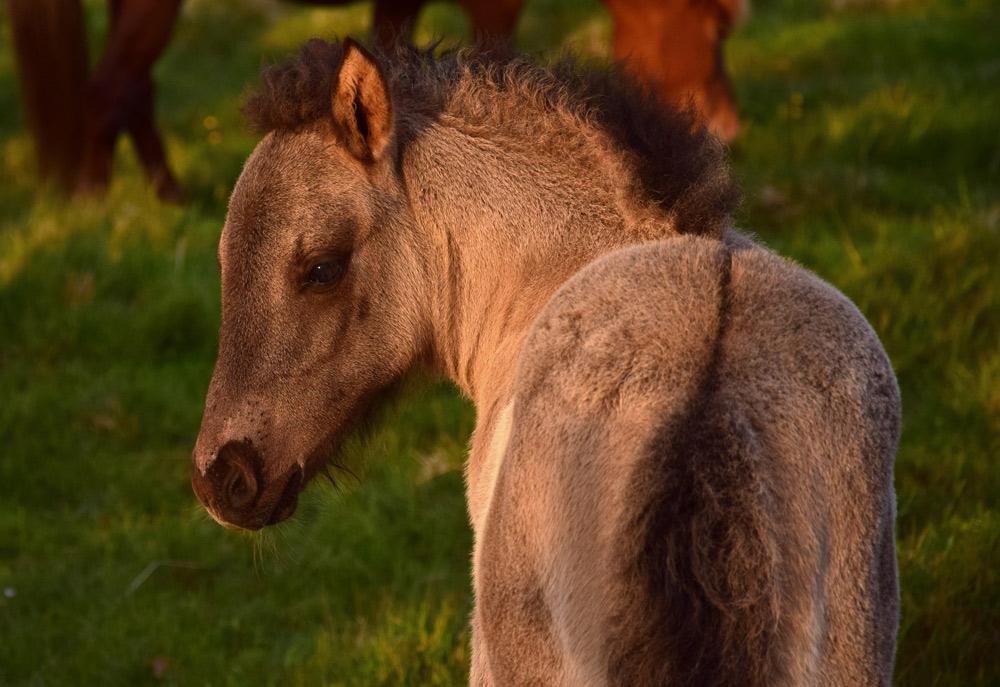Dun / Non-Dun (D / nd2 / nd1)
Gene or Region: TBX3
Reference Variant: G (D)
Mutant Variant: A (nd2)
Affected Breeds: Many
Research Confidence: D/ND1/ND2: High - Findings reproduced in multiple studies and strong association in studied population
Explanation of Results: D/D = homozygous for Dun, trait expressed D/nd1 or D/nd2 = heterozygous for Dun, trait expressed nd1/nd1 or nd2/nd2 = homozygous for non-Dun 1 or 2, no trait expressed
General Description for Dun/Non-Dun
Dun, a dominant dilution gene, is the ancestral coat color of equids. Both homozygous (D/D) and heterozygous (D/nd1 or D/nd2) horses display the same effects on the coat color. The dun dilution affects both pigment types equally (unlike the cream dilution), though the points often are darker than the body. Dun horses also display “primitive markings,” including a fully pigmented dorsal stripe, leg barring, shoulder stripes, face mask, face cobwebbing, ear stripes, and/or lighter hairs along the mane and tail (“frosting”.) The characteristic dilution is the result of pigments clustering asymmetrically to one side of the hair shaft. However, the lack of dun dilution is more common in most domestic horse breeds.
There are two known variants of the TBX3 gene that result in non-dun phenotypes. Non-dun 1 (nd1/nd1 or nd1/nd2) horses lack the distinct dilution seen in dun horses, but may still display some primitive markings. Non-dun 2 (nd2/nd2) horses lack both the distinct dilution seen in dun horses as well as the primitive markings.
Genotype and Phenotype
Black with dun (E/_ a/a D/): Grullo or Grulla Black with non-dun 1 (E/ a/a nd1/): Black with Primitive Markings Black with non-dun 2 (E/ a/a nd2/nd2): Black
Bay with dun (E/_ a/a D/): Bay Dun Bay with non-dun 1 (E/ a/a nd1/): Bay with Primitive Markings Bay with non-dun 2 (E/ a/a nd2/nd2): Bay
Chestnut with dun (e/e a/a D/): Red Dun Chestnut with non-dun 1 (e/e a/a nd1/): Chestnut with Primitive Markings Chestnut with non-dun 2 (e/e a/a nd2/nd2): Chestnut
- Other dilutions, modifiers, and spotting genes can further alter the color of a horse – for simplicity, we have not named all possible combinations!
Gene Information
TBX3 is a transcription factor that is critical for normal development. Mutations in other species cause abnormal limbs, genitals, teeth, and apocrine glands. The nd1 mutation (a single base change) and the nd2 mutation (a large deletion) alter the regulation of TBX3 in keratinocytes during hair growth. The negative phenotypes observed in other species have never been noted in non-dun horses.
References
Imsland F et al., “Regulatory mutations in TBX3 disrupt asymmetric hair pigmentation that underlies Dun camouflage color in horses.” (2016) Nat Genet. 48: 152-8.
More Horse Color Genetics
Congenital Stationary Night Blindness & Leopard Complex
Congential Stationary Night Blindness (CSNB) is characterized by the inability to see well in low light and no-light situations. It is linked to Leopard Complex Spotting (LP), where homozygous horses (LP/LP) will have CSNB. Congential Stationary Night Blindness is present at birth and is non-progressive.
Champagne
Champagne (CH) is a dilution that affects all coat colors. Champagne foals are born with pink skin and blue eyes that slightly darken with age. Adult champagne horses have a distinct pumpkin colored skin with mottling in the hairless regions, as well as amber/green/tan eyes. Horses with multiple dilutions can be difficult to accurately identify color without genetic testing.
